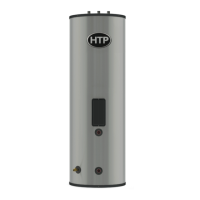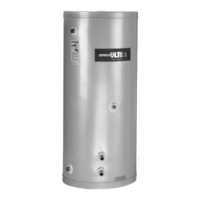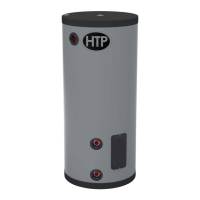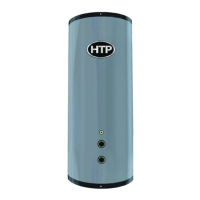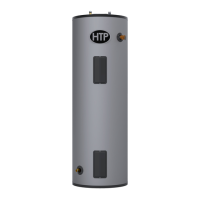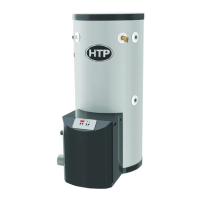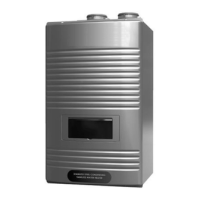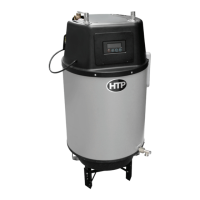lp-65 Rev. 1.6.15
7
Do not thread a cap or plug into the relief valve or relief valve
line under any circumstances! Explosion and property damage,
serious injury, or death may result.
RE-INSPECTION OF T&P RELIEF VALVES: T&P valves should
be inspected AT LEAST ONCE EVERY THREE YEARS, and
replaced if necessary, by a licensed plumbing contractor or
qualied service technician to ensure that the product has
not been aected by corrosive water conditions and to ensure
that the valve and discharged line have not been altered or
tampered with illegally. Certain naturally occuring conditions
may corrode the valve and its components over time, rendering
the valve inoperative. Such conditions can only be detected
if the valve and its components are physically removed and
inspected. Do not attempt to conduct an inspection on your
own. Contact your plumbing contractor for a re-inspection to
assure continued safety.
FAILURE TO RE-INSPECT THE T&P VALVE AS DIRECTED
COULD RESULT IN UNSAFE TEMPERATURE AND/OR
PRESSURE BUILD-UP WHICH CAN RESULT IN PROPERTY
DAMAGE, SERIOUS PERSONAL INJURY, OR DEATH.
F. Scalding
An ASSE 1017 or ASSE 1070 temperature limiting or mixing
valve is recommended in installations servicing disabled or
elderly persons, or children. Mixing valves do not eliminate the
risk of scalding.
To avoid scalding:
• Set the water heater set point temperature as low as
possible.
• Feel water before bathing or showering.
• If thermostatic valves are required, use devices
specically designed for such purpose. Install these
devices in accordance with instructions provided by the
manufacturer.
Failure to install a temperature limiting or mixing valve and
follow these instructions could result in property damage,
severe personal injury, or death due to scalds.
This water heater can
deliver scalding water. Be
careful whenever using
hot water to avoid scalding
injury. Certain appliances
such as dishwashers and
automatic clothes washers
may require increased
water temperatures. By
setting the thermostat
on this heater to obtain
the increased water
temperature required by
these appliances you may
create the potential for
scald injury.
To protect against injury,
install a mixing valve in the
water system. This valve
Approximate Time / Temperature Relationships in Scalds
120
o
F More than 5 minutes
125
o
F 1 1/2 to 2 minutes
130
o
F About 30 seconds
135
o
F About 10 seconds
140
o
F Less than 5 seconds
145
o
F Less than 3 seconds
150
o
F About 1 1/2 seconds
155
o
F About 1 second
Table 3 - Approximate Time / Temperature Relationships in Scalds
G. Potable Expansion Tank
A potable hot water expansion tank may be required to oset
heated water expansion. If there is a back ow preventer or any
other type of no return or check valve in the system a thermal
expansion tank IS MANDATORY. The expansion tank must be
sized for the entire water volume of the hot water system. A
weeping relief valve indicates the need for an expansion tank.
See the Typical Expansion Tank example in the Piping section for
details.
will reduce point of use discharge temperatures by mixing cold
and hot water in branch supply lines. Such valves are available
from your local plumbing supplier.
The following table details the relationship of water temperature
and time with regard to scald injury and may be used as a guide in
determining the safest water temperature for your applications.
H. Pressure Drop Sizing For Circulator
The boiler circulator ow rate must meet the requirements
found in the pressure drop sizing chart. The chart represents the
pipe run, water heater, and heat exchanger ONLY and does not
include any ow checks, zone valves, or friction loss through the
boiler. That resistance must be added to the value found in the
following chart.
Pressure Drop for Pipe Length of 1” Copper,
Six 90
o
Elbows, and One Tee
Model 20’ 30’ 40’ 50’ 60’
SSC-35 8 GPM 6.28 6.53 6.78 6.28 7.28
SSC-50 8 GPM 6.48 6.73 6.98 7.23 7.48
SSC-80 10 GPM 6.19 6.55 6.85 7.15 7.45
SSC-119 12 GPM 16.19 16.79 17.39 17.99 18.59
Table 4 - Pressure Drop through 1” and 1 1/4” Copper
